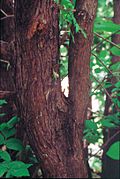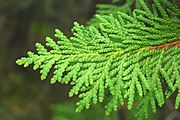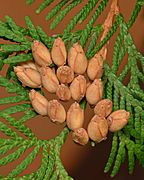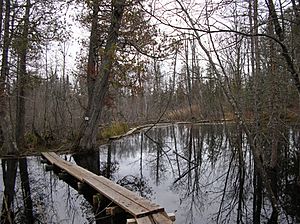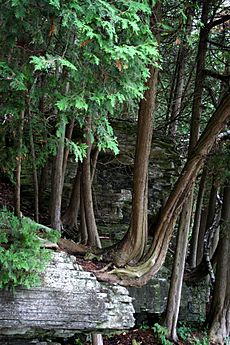Northern white cedar facts for kids
Quick facts for kids Northern white cedar |
|
|---|---|
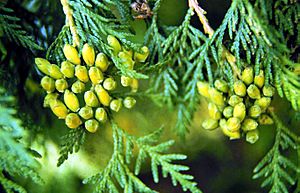 |
|
| Leaves and immature cones | |
| Conservation status | |
| Scientific classification | |
| Genus: |
Thuja
|
| Species: |
occidentalis
|
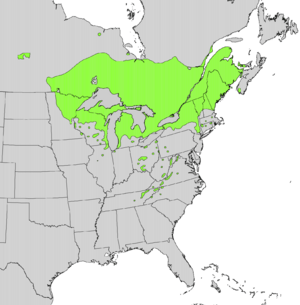 |
|
| Natural range | |
Thuja occidentalis, often called northern white cedar or eastern white cedar, is a type of evergreen tree. It belongs to the cypress family, called Cupressaceae. This tree naturally grows in eastern Canada and parts of the northern United States. Many people also grow it in their gardens as an ornamental plant.
Contents
What are its other names?
This tree has many common names. Some of these include swamp cedar and American arborvitae. The name arborvitae is very popular in gardening. It comes from Latin and means "tree of life." This name was given because people once believed the tree's sap, bark, and twigs had special healing powers.
Sometimes, it is called "white-cedar" to show it is different from Cedrus trees. Cedrus is a group of trees also called cedars, but they are not closely related to Thuja occidentalis.
What does the Northern White Cedar look like?
The northern white cedar is a small to medium-sized tree. It usually grows up to 15 meters (about 50 feet) tall. Its trunk can be about 0.9 meters (3 feet) wide. In rare cases, it can grow much taller, up to 38 meters (125 feet).
The tree's bark is reddish-brown. It has deep grooves and peels off in long, thin strips. The branches spread out like fans. The leaves are small and flat, shaped like scales. They are about 3 to 5 millimeters (about 1/8 to 1/4 inch) long.
The seed cones are thin and start as yellow-green. They turn brown when they are ready. These cones are about 9 to 14 millimeters (about 1/2 inch) long. Each cone has 6 to 8 scales and holds about 8 seeds. If a branch touches the ground, it can sometimes grow roots and start a new tree.
Where does the Northern White Cedar grow?
Northern white cedar is native to a large area. This area includes southern eastern Canada and the northern United States. You can find it from Manitoba in Canada, all the way to Nova Scotia. It also grows in states like New York, Vermont, and Maine. There are also smaller groups of these trees further south. These are found in states like Ohio, Illinois, and in the Appalachian Mountains.
This tree prefers places with cooler summers. The average temperature in July is usually between 16 to 22 degrees Celsius (61 to 72 degrees Fahrenheit). It also likes areas with a shorter growing season, from 90 to 180 days.
How does it live in nature?
Northern white cedar often grows in wet forests. It is very common in coniferous swamps. In these wet places, other larger trees cannot grow as well. This gives the white cedar a better chance to thrive. It also grows on cliffs where there is less competition from other trees.
Even though it is not currently endangered, wild white cedar trees face a threat. A large number of deer eat the soft evergreen leaves, especially in winter. This can harm the tree populations. The largest known northern white cedar is 34 meters (112 feet) tall. Its trunk is 175 centimeters (69 inches) wide. This huge tree is on South Manitou Island in Michigan.
Northern white cedars can live for a very long time. Some very old trees grow on cliffs where deer cannot reach them. These trees are also safe from wildfires. In 2008, the oldest living tree found was 1,141 years old. Scientists even found a dead tree that had 1,653 growth rings! These very old trees are often small and twisted because they grow in tough conditions. Their long lives are due to slow growth. They can also survive even if parts of the tree are damaged.
The Witch Tree is a famous T. occidentalis tree. It grows out of a cliff face on Lake Superior in Minnesota. A French explorer saw it in 1731, and it was already a mature tree then. It is still alive today! Trees found on cliff faces in southern Ontario are the oldest in Eastern North America and all of Canada. Some of them are more than 1,653 years old.
What are the uses of Northern White Cedar?
Thuja occidentalis is very important in traditional Ojibwe culture. They call it Nookomis Giizhik, which means "Grandmother Cedar." The Ojibwe people have sacred stories about this tree. They see it as a gift because it has so many uses. They use it for crafts, building, and medicine.
Commercially, this tree's wood is used for many things. It is popular for fences, posts, and shingles. It is also used to build log cabins. The wood is also the best choice for making parts of birchbark canoes. It is used for the ribs and planking of wooden canoes.
The natural oil from the plant has many uses too. It is found in cleansers, disinfectants, and hair products. It is also used in insecticides and room sprays. Some reports say the Ojibwa made a soup from the inner bark of the soft twigs. Others used the twigs to make teas to help with constipation and headaches.
How is it grown in gardens?
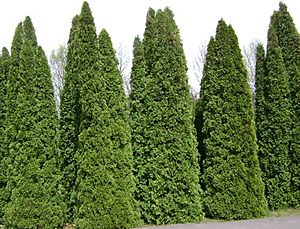
Thuja occidentalis is a very popular ornamental tree. People often plant it in gardens, parks, and cemeteries. It is great for creating screens or hedges. There are over 300 different types, called cultivars. These types vary a lot in color, shape, and size. Some common ones include 'Smaragd' (also known as 'Emerald Green') and 'Rheingold'. This tree was first brought to Europe as early as 1540.
Several types of Thuja occidentalis have won awards. The Royal Horticultural Society has given its Award of Garden Merit to these cultivars:
- 'Danica'
- 'Golden Tuffet'
- 'Holmstrup'
- 'Rheingold'
- 'Smaragd'
Images for kids
See also
 In Spanish: Tuya del Canadá para niños
In Spanish: Tuya del Canadá para niños



